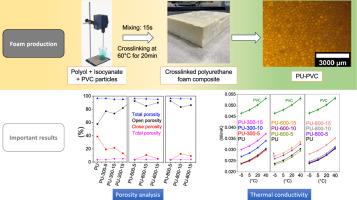用报废聚氯乙烯泡沫颗粒改变硬质聚氨酯泡沫的性能
IF 10.9
1区 环境科学与生态学
Q1 ENGINEERING, ENVIRONMENTAL
引用次数: 0
摘要
报废(EoL)硬质交联聚氯乙烯(PVC)泡沫塑料在废物管理中需要经过焚烧或填埋等危险程序。这项工作旨在利用聚氯乙烯废料来改变硬质聚氨酯(PU)泡沫的性能。聚氯乙烯废料经筛分后得到不同大小的颗粒,并与多元醇/异氰酸酯混合物均匀混合。改性泡沫的几何密度随着聚氯乙烯颗粒的逐渐添加而增加,其中 300 μm 聚氯乙烯颗粒的效果更为明显。这些泡沫的形态分析表明,聚氨酯细胞结构的细胞尺寸减小,开放孔隙率增加。此外,添加了聚氯乙烯颗粒的聚氨酯泡沫的绝缘性能并没有明显下降。聚氨酯泡沫的阻尼效应也通过共振测试得到了验证,在共振测试中观察到了尺寸效应,阻尼比增加,从而提高了这种绝缘结构的实用性。本文章由计算机程序翻译,如有差异,请以英文原文为准。

Property modification of rigid polyurethane foam by end-of-life polyvinyl chloride foam particles
End-of-life (EoL) rigid crosslinked polyvinyl chloride (PVC) foams are subjected to hazardous procedure of incineration or landfilling for waste management. This work aims to valorize PVC waste for the property variation of rigid polyurethane (PU) foam. PVC waste was sieved to obtain different sized particles and were mixed homogenously in polyol/isocyanate mixture. The geometrical density of modified foams increased with the progressive addition of the PVC particles, the effect of which was more pronounced with 300 μm PVC particles. Morphological analysis of these foams revealed a reduction in cell size and an increase in the open porosity of the PU cell structure. Moreover, PU foams loaded with PVC particles did not manifest a severe reduction of the former's insulating property. The effect of damping in PU foams was also verified by resonance tests where a size effect was observed, increasing the damping ratio and thus enhancing the usefulness of such insulating structures.
求助全文
通过发布文献求助,成功后即可免费获取论文全文。
去求助
来源期刊

Resources Conservation and Recycling
环境科学-工程:环境
CiteScore
22.90
自引率
6.10%
发文量
625
审稿时长
23 days
期刊介绍:
The journal Resources, Conservation & Recycling welcomes contributions from research, which consider sustainable management and conservation of resources. The journal prioritizes understanding the transformation processes crucial for transitioning toward more sustainable production and consumption systems. It highlights technological, economic, institutional, and policy aspects related to specific resource management practices such as conservation, recycling, and resource substitution, as well as broader strategies like improving resource productivity and restructuring production and consumption patterns.
Contributions may address regional, national, or international scales and can range from individual resources or technologies to entire sectors or systems. Authors are encouraged to explore scientific and methodological issues alongside practical, environmental, and economic implications. However, manuscripts focusing solely on laboratory experiments without discussing their broader implications will not be considered for publication in the journal.
 求助内容:
求助内容: 应助结果提醒方式:
应助结果提醒方式:


